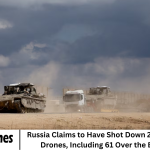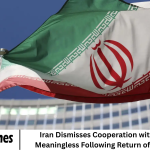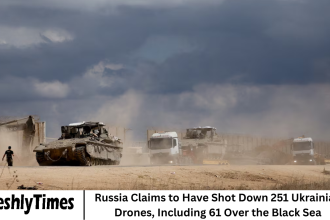Russian President Vladimir Putin has issued one of his starkest warnings yet to Washington, cautioning that any decision by the United States to supply Tomahawk cruise missiles to Ukraine would have “catastrophic consequences” for bilateral relations.
- The Context: Washington’s Possible Tomahawk Transfer
- Putin’s Remarks: A “Point of No Return”
- Russian Officials Echo the Threat
- Washington’s Response: Measured but Firm
- Why the Tomahawk Is So Controversial
- Global Reaction: Europe Divided
- China and Other Global Players React
- Analysts Weigh In: A Dangerous Escalation
- Potential Russian Countermeasures
- Impact on Ukraine’s War Strategy
- Diplomatic Fallout: The End of Dialogue?
- Economic and Energy Implications
- Historical Parallels: Echoes of the Cold War
- Possible Off-Ramps: Diplomacy Still Alive?
- Frequently Asked Question
- Conclusion
Speaking during a press conference in Moscow, Putin accused the U.S. of “crossing a red line” that could permanently sever what remains of the diplomatic ties between the two nuclear superpowers. The statement comes amid growing speculation that the Biden administration.
May consider transferring long-range Tomahawk missiles to Kyiv as part of a new military assistance package. The move, reportedly under discussion within the Pentagon and Congress, aims to bolster Ukraine’s deep-strike capabilities against Russian positions as the war grinds into its fourth year.
More Read: Global Trade War Escalates as China Retaliates Against Trump Tariffs, Sending Markets Plunging
The Context: Washington’s Possible Tomahawk Transfer
The Tomahawk missile, a precision-guided, long-range cruise missile capable of striking targets more than 1,000 miles away, has long been a central element of the U.S. military’s arsenal. Its potential transfer to Ukraine marks a new chapter in Western support for Kyiv.
Following previous deliveries of HIMARS rocket systems, Patriot air defense batteries, and F-16 fighter jets. Reports from Washington suggest that senior U.S. defense officials are considering whether providing Ukraine with Tomahawk missiles could help.
Kyiv regain momentum on the battlefield after months of stagnation. Ukrainian officials have argued that such long-range systems are essential to strike deep into Russian supply lines, airfields, and command centers.
However, the proposal has triggered alarm in Moscow. The Kremlin views any weapons capable of hitting targets inside Russia as a direct threat to its national security. Putin’s warning on the issue leaves little doubt about how seriously Russia perceives such a move.
Putin’s Remarks: A “Point of No Return”
During a televised appearance following a meeting with his national security council, Putin said that if the United States delivered Tomahawk missiles to Ukraine, it would represent an “irreversible escalation” in the conflict.
“If the U.S. decides to transfer Tomahawk missiles to the Kyiv regime, it will destroy what remains of Russian-American relations,” Putin said. “Such an action would be viewed as direct participation in the conflict and will not go unanswered.”
The Russian leader further accused Washington of “testing Russia’s patience” and “deliberately pushing the world toward a wider confrontation.” He did not specify what kind of response Moscow might take but hinted at both “military and political consequences.”
Putin’s language was unambiguous and reflected his growing frustration with Western involvement in Ukraine. The Kremlin’s message was intended not only for Washington but also for European allies, many of whom are debating their own levels of military support to Kyiv.
Russian Officials Echo the Threat
Following Putin’s remarks, several senior Russian officials reinforced the president’s warning. Foreign Minister Sergey Lavrov said that any deployment of Tomahawk missiles in Ukraine would make U.S. military facilities and assets “legitimate targets.”
“The supply of such weapons would mark a new phase of direct U.S. involvement,” Lavrov said. “This would force Russia to take measures that the American side will not like.”
Kremlin spokesperson Dmitry Peskov also stated that Moscow would consider the missile transfer as evidence that the U.S. had become “a direct party to the conflict,” not merely a supporter of Ukraine. He warned that Moscow could respond with “asymmetric steps” designed to increase pressure on U.S. interests globally.
Washington’s Response: Measured but Firm
In Washington, U.S. officials responded cautiously to Putin’s remarks. White House National Security Council spokesperson John Kirby said that while the administration would not confirm any new weapons package, Washington would “continue to provide Ukraine with the capabilities it needs to defend itself.”
“We are aware of President Putin’s statements,” Kirby said. “The United States is not seeking a confrontation with Russia. But let’s be clear: Russia invaded Ukraine. The only reason this war continues is because of Moscow’s refusal to end its aggression.”
Pentagon officials, speaking on condition of anonymity, suggested that discussions about providing Tomahawk missiles were still “preliminary” and would require careful assessment of how such systems could be deployed and controlled by Ukrainian forces.
Why the Tomahawk Is So Controversial
The Tomahawk cruise missile has long been a symbol of American military precision and power projection. First used during the 1991 Gulf War, the missile has been deployed in numerous U.S. operations in Iraq, Syria, and Libya.
It can carry a 1,000-pound warhead and fly at low altitudes, evading radar detection over long distances. For Ukraine, the potential acquisition of Tomahawks would significantly enhance its strike capability, allowing it to target key Russian installations far behind the frontlines.
For Moscow, however, the missile’s range and destructive power raise fears that Ukraine could hit Russian territory or critical infrastructure such as oil depots, airbases, or command centers deep inside Russia.
Analysts say that while Ukraine would likely use such weapons for tactical military purposes, Russia’s perception of the threat is strategic — a factor that greatly increases the risk of escalation.
Global Reaction: Europe Divided
Putin’s warning has put European governments in an uneasy position. NATO allies, while largely united in their support for Ukraine, remain divided on the extent to which they should provide long-range offensive weapons.
The United Kingdom and France have already supplied Storm Shadow and SCALP cruise missiles to Ukraine, though these systems have shorter ranges compared to the Tomahawk. Germany, meanwhile, continues to resist pressure to send its Taurus missiles, fearing it could provoke a direct confrontation with Moscow.
In Brussels, EU officials called for restraint, emphasizing the need to “avoid further destabilization.” European Commission President Ursula von der Leyen reiterated that Europe must “stand by Ukraine,” but warned that every step must be taken with “strategic caution.”
China and Other Global Players React
China, a key Russian partner, also weighed in on the controversy. Beijing’s foreign ministry said it was “deeply concerned” by the potential escalation and urged all parties to “exercise restraint and seek a political solution.” China’s position aligns closely with Moscow’s narrative, portraying the U.S. as an instigator of global instability.
Meanwhile, countries such as India, Turkey, and Brazil called for renewed diplomatic efforts to end the conflict. Turkey’s President Recep Tayyip Erdoğan stated that “continued escalation benefits no one,” warning that “any further militarization of the conflict risks spreading beyond Ukraine’s borders.”
Analysts Weigh In: A Dangerous Escalation
Military and political analysts have described the situation as one of the most dangerous moments since the start of the war. According to experts at the International Institute for Strategic Studies (IISS), transferring Tomahawk missiles would “significantly alter”.
The balance of capabilities in Ukraine’s favor, but also increase the likelihood of a Russian retaliatory response. Dr. Michael Kofman, a senior fellow at the Carnegie Endowment for International Peace, noted that Putin’s warning should be taken seriously.
“Putin’s message is consistent with his deterrence posture throughout the war,” Kofman said. “Every time the U.S. has increased its support for Ukraine — whether through HIMARS, tanks, or F-16s — Russia has issued threats.
But the difference here is that Tomahawks could strike deep into Russian territory, which raises the stakes dramatically.”
Potential Russian Countermeasures
If the U.S. were to move forward with the missile transfer, Russia could respond through a range of measures — both military and diplomatic. Analysts believe possible reactions could include:
- Expanding Strikes in Ukraine – Russia could intensify its bombardment of Ukrainian infrastructure and government facilities.
- Targeting U.S. Interests Abroad – Moscow might increase its pressure in regions like the Middle East or Africa where American and Russian interests overlap.
- Cyber Operations – Russia could launch large-scale cyberattacks against Western networks as a form of retaliation.
- Suspending Diplomatic Channels – The Kremlin could expel U.S. diplomats or freeze ongoing nuclear arms control talks.
- Strategic Military Posturing – Russia may increase its nuclear readiness levels or conduct military exercises near NATO borders.
While none of these actions necessarily mean a direct confrontation, they would signal a severe deterioration of relations not seen since the Cold War.
Impact on Ukraine’s War Strategy
For Ukraine, the prospect of acquiring Tomahawk missiles offers both opportunity and risk. Ukrainian defense planners believe that long-range weapons could allow them to disrupt Russian logistics networks and weaken Moscow’s control over occupied territories.
President Volodymyr Zelenskyy has repeatedly appealed to Western allies for more advanced systems to “bring victory closer.” However, Ukrainian officials are also aware that such a transfer could escalate tensions to dangerous levels.
Kyiv has often had to balance its military needs with the political realities of keeping Western support unified. A senior Ukrainian defense source told The Kyiv Independent that while Tomahawks would be “a game-changer,” Ukraine would use them “strictly against military targets.”
“We are not interested in striking Russia for the sake of it,” the official said. “Our goal is to liberate our land, not to provoke a wider war.”
Diplomatic Fallout: The End of Dialogue?
The warning from Putin also signals the possible end of what little diplomatic engagement remains between Moscow and Washington. Since Russia’s invasion of Ukraine in February 2022, communication between the two capitals has been limited mostly to deconfliction hotlines and sporadic talks over nuclear arms treaties.
If the U.S. were to provide Tomahawks, analysts believe it could lead to the complete collapse of diplomatic dialogue — including discussions on arms control, prisoner exchanges, and other areas of mutual concern.
Former U.S. ambassador to Russia Michael McFaul commented: “We’re at the edge of an abyss. The Tomahawk issue could push U.S.-Russia relations into a deep freeze that might last for a generation.”
Economic and Energy Implications
Beyond the military and diplomatic dimensions, the escalating tension could also reverberate through global markets. Energy analysts warn that a further breakdown in U.S.-Russia relations could destabilize oil and gas supplies, particularly in Europe.
Russia remains one of the world’s largest energy exporters, and any renewed sanctions or disruptions could drive prices upward. Financial markets have already shown signs of unease. The ruble fell sharply following Putin’s remarks, while crude oil prices climbed amid fears of geopolitical instability.
If history is any guide, worsening relations between Washington and Moscow tend to ripple across sectors — from global trade to cybersecurity — creating uncertainty that investors loathe.
Historical Parallels: Echoes of the Cold War
Putin’s rhetoric bears strong resemblance to the language used during the Cold War, when both superpowers regularly issued stern warnings over missile deployments and military aid to proxy states.
Many historians point to the Cuban Missile Crisis of 1962 as an example of how quickly tensions can spiral when nuclear-capable powers test each other’s boundaries.
Today’s geopolitical environment is different, yet some dynamics remain eerily familiar. Both sides accuse the other of aggression, both are armed with vast nuclear arsenals, and both believe they are acting defensively.
The difference, however, is that this time the confrontation is unfolding in the heart of Europe, with the potential to draw in dozens of countries.
Possible Off-Ramps: Diplomacy Still Alive?
Despite the harsh rhetoric, some experts believe there may still be room for diplomacy. U.N. Secretary-General António Guterres urged the United States and Russia to “keep communication open,” warning that “a breakdown in dialogue between nuclear powers is the most dangerous development imaginable.”
Backchannel diplomacy — involving intermediaries such as Turkey, Switzerland, or China — could still provide opportunities for de-escalation. But for now, both sides appear entrenched in their positions.
The U.S. insists it will continue to arm Ukraine “as long as it takes,” while Russia vows to respond to any further Western intervention with “decisive action.”
Frequently Asked Question
What exactly did Vladimir Putin say about Tomahawk missiles?
Putin warned that if the U.S. supplies Tomahawk cruise missiles to Ukraine, it would “destroy what remains of U.S.-Russia relations.” He said such a move would be viewed as a direct act of aggression and would prompt “serious consequences.”
What are Tomahawk missiles, and why are they significant?
Tomahawks are long-range, precision-guided cruise missiles capable of striking targets over 1,000 miles away. They are used by the U.S. Navy and can be launched from ships or submarines. For Ukraine, they would provide a dramatic boost in deep-strike capability against Russian targets.
Has the U.S. confirmed it will send Tomahawk missiles to Ukraine?
As of now, Washington has not confirmed any such decision. Officials say discussions are ongoing but emphasize that no final agreement has been reached.
Why does Russia consider this a “red line”?
Russia believes that any weapons capable of hitting deep inside its territory pose an existential threat. The Kremlin views the transfer of long-range missiles as crossing a “red line” that would mean the U.S. is no longer a supporter of Ukraine, but an active participant in the war.
Could this situation lead to direct conflict between the U.S. and Russia?
While both sides likely want to avoid a direct military clash, the risk of miscalculation is high. Experts warn that the introduction of Tomahawks could bring the two nuclear powers dangerously close to confrontation.
How has the global community reacted to Putin’s warning?
Reactions have been mixed. NATO allies have expressed concern but reaffirmed their support for Ukraine. China and several non-aligned countries have called for restraint and renewed diplomatic efforts to prevent further escalation.
What might happen next in U.S.-Russia relations?
If the U.S. proceeds with the missile transfer, relations could collapse to their lowest point since the Cold War. Possible outcomes include diplomatic expulsions, cyberattacks, economic sanctions, or even the suspension of arms control treaties.
Conclusion
Putin’s warning about Tomahawk missiles marks a new flashpoint in the already fraught relationship between Moscow and Washington. The message is clear: Russia views the potential transfer as an existential threat and is prepared to respond in kind.
Whether the U.S. ultimately decides to go ahead with such a move will depend on a delicate balance of military necessity, political will, and strategic restraint. What is certain, however, is that the decision could redefine the trajectory of the war — and the future of U.S.-Russia relations — for years to come.














